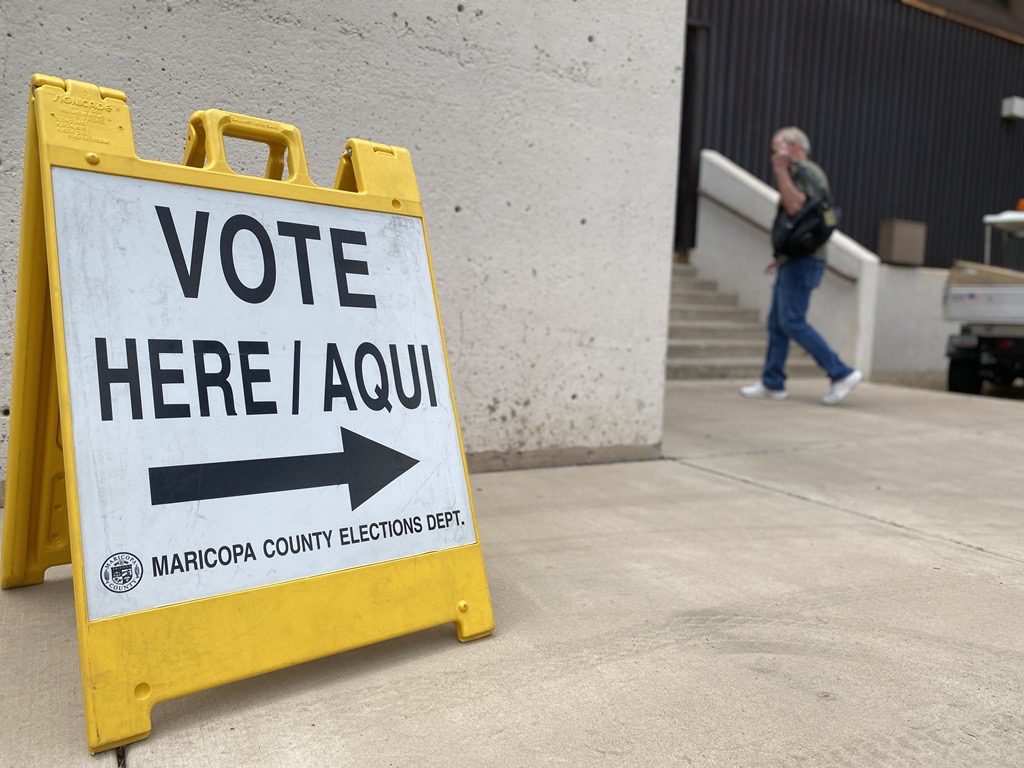Ohioans Reject GOP Effort to Weaken Direct Democracy, in Big Win for Abortion Rights
Tuesday’s referendum, which Republicans rushed ahead of a November showdown over abortion, was the latest in a series of GOP efforts nationwide to make it harder for voters to propose and pass ballot initiatives.
| August 9, 2023

Ohio voters have roundly rejected Republicans’ attempt to undermine direct democracy and kneecap a looming vote to protect abortion rights in the state.
A measure to change Ohio’s constitution to make it harder to pass future constitutional amendments failed on Tuesday. With an estimated 65 percent of the vote counted on Tuesday night, more than 57 percent of Ohioans voted against Issue 1, the GOP-backed constitutional amendment.
The result is a major victory for Democrats, liberals and abortion rights in a state that has trended hard to the right over the past decade—and keeps alive Ohioans’ ability to circumvent the Republican-controlled legislature to achieve policy changes in the coming years.
“Ohio voters refused to vote to give up their own power. They saw through the outright lies and obfuscation,” Mia Lewis of Common Cause Ohio, a good-government group that opposed the measure, texted Bolts. “They stood up for majority rule and their right to bring issues to the ballot. We are thrilled. This is a good day for democracy!”
Issue 1 proposed to raise the threshold of passage for future initiatives from 50 to 60 percent. It also would have made it harder to qualify measures for the ballot by increasing the number of petition signatures groups would need to qualify an issue for the ballot..
Most immediately and significantly, its failure means that this November’s constitutional referendum to protect abortion rights will only need to surpass 50 percent of the vote to be enshrined in the state constitution.
The Ohio ballot measure is the latest state-level referendum to protect abortion rights after the Supreme Court struck down Roe v. Wade in 2022, following successful statewide votes to protect abortion rights in California, Kansas, Michigan, and Vermont.
The election turned into an expensive and hard-fought proxy battle over abortion rights, with tens of millions of dollars pouring in from national groups on both sides of the issue.
But that’s far from the only looming policy fight where this threshold matters: Unions and Democrats are also gearing up for a 2024 ballot initiative to raise Ohio’s minimum wage to $15 by 2028.
The measure would have significantly curtailed a tool Ohio voters have available to them for more than a century. The 50 percent referendum threshold has existed since 1912.
The result is also a significant setback for the conservative politicians who, after months of infighting, backed a statewide referendum to change the threshold to amend Ohio’s constitution by popular vote and make it harder to get constitutional amendments on the ballot in the first place. Those include Secretary of State Frank LaRose, who campaigned hard for it and is running in next year’s election for the U.S. Senate, as well as the GOP state legislators who created the referendum in the first place.
While some Republicans claimed otherwise, they also admitted that kneecapping November’s abortion referendum was their motivation for holding the vote now.
Republican legislators passed a law in December that banned August elections because they were expensive to hold, unnecessary and bad for democracy because of historically low turnout during the quiet, hot month when many people take vacation during schools’ summer break. And the 60 percent threshold they chose was notable given that multiple polls have found that significantly more than 50 percent of Ohioans support the abortion rights vote—but most found that number just below 60 percent.
Voter turnout for Tuesday’s election was sky-high, especially given the unusual timing of the election and the fact that the referendum was the only thing on the ballot.
More voters turned out for Tuesday’s referendum than in the state’s 2022 primaries, a remarkable result given that those primaries featured many competitive races, including for governor and the U.S. Senate.
And it’s the latest example of Republicans looking to undermine direct democracy and limit voters’ ability to overrule them on policy. Arkansas Republicans recently made it harder to qualify issues for ballot measures, and Utah Republicans did the same in 2021.
When voters have had their say on these changes, though, they have tended to reject them. South Dakotans rejected a GOP-backed constitutional amendment to increase the threshold to pass ballot initiatives last summer; Republicans had called the vote just months before a major showdown over Medicaid expansion in November. A similar measure in 2022 failed in Arkansas.
Ohio’s result indicates just how potent an issue abortion rights remains for voters even in GOP-leaning states, and following successful statewide votes in places like Kansas shows that this will remain a powerful issue for Democrats.
The coalition of liberal groups were confident from the start that they would prevail on this vote, but didn’t take any chances, outraising and outspending their opponents by a wide margin for much of the race.
But in the election’s final weeks, conservative groups backing the referendum poured an additional $5 million into a last-minute statewide TV buy, according to sources tracking advertising, pulling the two sides roughly to parity in the race.
Both sides mixed their messaging on the referendum, targeting different groups with specific messages given the sweeping implications of the vote. Pro- and anti-abortion rights groups spent heavily to turn out their base voters on the issue while also painting it as a fight for checks on power and fundamental principles of democracy.
On top of that, those opposing the measure spent heavily to make it clear this would further empower politicians and take away Ohioans’ ability to overrule their elected officials. Those supporting the bill ran ads arguing that the referendum would make it harder for deep-pocketed out-of-state interests to spend heavily to change state policy—a deeply ironic message given that the vast majority of money spent on this race (on both sides) came from out of state. They also claimed that the groups opposing the referendum supported “ “abolishing parental rights” and sent voters mailers arguing that this measure would not only prevent abortion rights from taking hold in Ohio, but keep a whole host of progressive ideals at bay, from “critical race theory” to ideas about gender and sexuality being taught in schools.
But it was clear—to both supporters and detractors—that the main things they were voting on was abortion rights and their ability to change the state constitution. And Ohioans resoundingly declared that they want to preserve both rights.
“The voters made it clear that the power of the people will always rise above deceitful, out-of-touch politicians,” said House Minority Leader Allison Russo, a Democrat, texted Bolts. “Ohio’s constitution and the people’s fundamental freedom to determine our own future has been preserved, but the fight is not over. Citizen-led ballot initiatives give voice to the power of the people, and it will never be silenced.”
Sign up and stay up-to-date
Support us
Bolts is a non-profit newsroom that relies on donations, and it takes resources to produce this work. If you appreciate our value, become a monthly donor or make a contribution.




